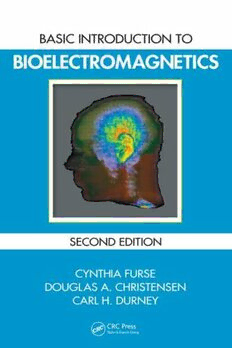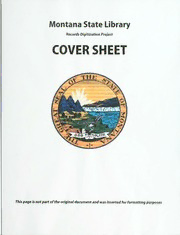
Kinematics and Dynamics of Mechanical Systems, Second Edition: Implementation in MATLAB® and SimMechanics® PDF
Preview Kinematics and Dynamics of Mechanical Systems, Second Edition: Implementation in MATLAB® and SimMechanics®
Kinematics and Dynamics of Mechanical Systems Implementation in MATLAB® and Simmechanics® Kinematics and Dynamics of Mechanical Systems Implementation in MATLAB® and Simmechanics® Second Edition Kevin Russell, Qiong Shen, Raj S. Sodhi MATLAB® and Simulink® are trademarks of The MathWorks, Inc. and are used with permission. The MathWorks does not war- rant the accuracy of the text or exercises in this book. This book’s use or discussion of MATLAB® and Simulink® software or related products does not constitute endorsement or sponsorship by The MathWorks of a par- ticular pedagogical approach or particular use of the MATLAB® and Simulink® software. CRC Press Taylor & Francis Group 6000 Broken Sound Parkway NW, Suite 300 Boca Raton, FL 33487-2742 © 2019 by Taylor & Francis Group, LLC CRC Press is an imprint of Taylor & Francis Group, an Informa business No claim to original U.S. Government works Printed on acid-free paper International Standard Book Number-13: 978-1-4987-2493-7 (Hardback) This book contains information obtained from authentic and highly regarded sources. Reasonable efforts have been made to publish reliable data and information, but the author and publisher cannot assume responsibility for the validity of all materials or the consequences of their use. The authors and publishers have attempted to trace the copyright holders of all material reproduced in this publication and apologize to copyright holders if permission to publish in this form has not been obtained. If any copyright material has not been acknowledged please write and let us know so we may rectify in any future reprint. Except as permitted under U.S. Copyright Law, no part of this book may be reprinted, reproduced, transmitted, or utilized in any form by any electronic, mechanical, or other means, now known or hereafter invented, including pho- tocopying, microfilming, and recording, or in any information storage or retrieval system, without written permission from the publishers. For permission to photocopy or use material electronically from this work, please access www.copyright.com (http:// www.copy- right.com/) or contact the Copyright Clearance Center, Inc. (CCC), 222 Rosewood Drive, Danvers, MA 01923, 978-750-8400. CCC is a not-for-profit organization that provides licenses and registration for a variety of users. For organizations that have been granted a photocopy license by the CCC, a separate system of payment has been arranged. Trademark Notice: Product or corporate names may be trademarks or registered trademarks, and are used only for identification and explanation without intent to infringe. Library of Congress Cataloging-in-Publication Data Names: Russell, Kevin (Mechanical engineer), author. | Shen, Qiong (Mechanical engineer), author. | Sodhi, R. S. (Raj S.), author. Title: Kinematics and dynamics of mechanical systems : implementation in MATLAB and SimMechanics / Kevin Russell, Qiong Shen, Raj S. Sodhi. Description: Boca Raton : CRC Press, Taylor & Francis, 2018. | Includes index. Identifiers: LCCN 2018022923 | ISBN 9781138584044 (hardback) Subjects: LCSH: Machinery, Kinematics of--Computer simulation. | Machinery, Dynamics of—Computer simulation. | MATLAB. | SimMechanics. Classification: LCC TJ175 .R87 2018 | DDC 621.01/5311—dc23 LC record available at https://lccn.loc.gov/2018022923 Visit the Taylor & Francis Web site at http://www.taylorandfrancis.com and the CRC Press Web site at http://www.crcpress.com Contents Preface ...........................................................................................................................................xiii Authors ........................................................................................................................................xvii 1. Introduction to Kinematics ..................................................................................................1 1.1 Kinematics ......................................................................................................................1 1.2 Kinematic Chains and Mechanisms ..........................................................................2 1.3 Mobility, Planar, and Spatial Mechanisms ................................................................3 1.4 Types of Mechanism Motion .......................................................................................5 1.5 Kinematic Synthesis .....................................................................................................7 1.6 Units and Conversions .................................................................................................8 1.7 Software Resources .......................................................................................................9 1.8 Summary ........................................................................................................................9 References ...............................................................................................................................10 Additional Reading ...............................................................................................................11 2. Mathematical Concepts in Kinematics ............................................................................13 2.1 Introduction .................................................................................................................13 2.2 Complex Numbers and Operations .........................................................................13 2.2.1 Complex Number Forms ..............................................................................13 2.2.2 Complex Number Addition ..........................................................................15 2.2.3 Complex Number Multiplication and Differentiation .............................17 2.3 Vector and Point Representation ..............................................................................20 2.4 Linear Simultaneous Equations, Matrices, and Matrix Operations ....................22 2.4.1 Linear Simultaneous Equation Systems and Matrices .............................22 2.4.2 Matrix Transpose, Addition, Subtraction, and Multiplication ................23 2.4.3 The Identity Matrix and Matrix Inversion .................................................26 2.5 Intermediate and Total Spatial Motion ....................................................................29 2.6 General Transformation Matrix ................................................................................33 2.7 Summary ......................................................................................................................36 References ...............................................................................................................................37 Additional Reading ...............................................................................................................37 Problems ..................................................................................................................................37 3. Fundamental Concepts in Kinematics .............................................................................41 3.1 Types of Planar and Spatial Mechanisms ...............................................................41 3.1.1 Planar Four-Bar Mechanism ........................................................................41 3.1.2 S lider-Crank Mechanism ..............................................................................41 3.1.3 Geared Five-Bar Mechanism ........................................................................42 3.1.4 Planar Multiloop Six-Bar Mechanisms .......................................................44 3.1.5 Spatial Four-Bar Mechanisms ......................................................................45 3.2 Links, Joints, and Mechanism Mobility ...................................................................46 3.3 Number Synthesis .......................................................................................................49 3.4 Grashof’s Criteria and Transmission Angle ............................................................50 3.5 Circuit Defect ...............................................................................................................53 v vi Contents 3.6 Mechanism Inversion .................................................................................................54 3.7 Passive Degree of Freedom and Paradoxes .............................................................55 3.8 Summary ......................................................................................................................56 References ...............................................................................................................................57 Problems ..................................................................................................................................58 4. Kinematic Analysis of Planar Mechanisms ....................................................................63 4.1 Introduction .................................................................................................................63 4.2 Numerical Solution Method for Two Simultaneous Equations ...........................64 4.3 Link Velocity and Acceleration Components in Planar Space .............................64 4.4 Four-Bar Mechanism Analysis .................................................................................66 4.4.1 Displacement Equations ...............................................................................66 4.4.2 Velocity Equations .........................................................................................67 4.4.3 Acceleration Equations ..................................................................................68 4.4.4 Kinematics of Coupler Locations of Interest ..............................................70 4.4.5 Instant Center, Centrodes, and Centrode Generation ..............................76 4.5 Slider-Crank Mechanism Analysis ..........................................................................80 4.5.1 Displacement Equations ...............................................................................80 4.5.2 Velocity Equations .........................................................................................81 4.5.3 Acceleration Equations ..................................................................................83 4.5.4 Centrode Generation .....................................................................................89 4.6 Geared Five-Bar Mechanism Analysis ....................................................................91 4.6.1 D isplacement Equations ...............................................................................91 4.6.2 V elocity Equations .........................................................................................92 4.6.3 A cceleration Equations ..................................................................................93 4.6.4 K inematics of Intermediate Link Locations of Interest ............................95 4.7 Watt II Mechanism Analysis .....................................................................................97 4.8 Stephenson III Mechanism Analysis ......................................................................100 4.8.1 D isplacement Equations .............................................................................100 4.8.2 V elocity Equations .......................................................................................103 4.8.3 A cceleration Equations ................................................................................104 4.8.4 K inematics of Intermediate Link Locations of Interest ..........................105 4.9 Time and Driver Angular Velocity .........................................................................108 4.10 Mechanism Configurations .....................................................................................108 4.11 Constructing Cognates.............................................................................................109 4.12 Planar Mechanism Kinematic Analysis and Modeling in Simmechanics® ......112 4.13 Summary ....................................................................................................................117 References .............................................................................................................................118 Additional Reading .............................................................................................................118 Problems ................................................................................................................................118 5. Dimensional Synthesis......................................................................................................131 5.1 Introduction ...............................................................................................................131 5.2 Branch and Order Defects .......................................................................................133 5.3 Planar Four-Bar Motion Generation: Three Precision Positions ........................135 5.4 Order- and Branch-Defect Elimination .................................................................140 5.5 Path Generation versus Motion Generation ..........................................................144 5.6 Stephenson III Motion Generation: Three Precision Positions ...........................145 5.7 Planar Four-Bar Function Generation: Three Precision Points ..........................149 Contents vii 5.8 Planar Four-Bar Function Generation: FSPs and MSPs .......................................153 5.9 Mechanism Dimensions: From Dimensional Synthesis to Kinematic Analysis ...................................................................................................158 5.10 Summary ....................................................................................................................163 References .............................................................................................................................164 Additional Reading .............................................................................................................165 Problems ................................................................................................................................165 6. Static Force Analysis of Planar Mechanisms ................................................................175 6.1 Introduction ...............................................................................................................175 6.2 Static Loading in Planar Space ................................................................................176 6.3 Four-Bar Mechanism Analysis ...............................................................................177 6.4 Slider-Crank Mechanism Analysis ........................................................................182 6.5 Geared Five-Bar Mechanism Analysis ..................................................................185 6.6 Watt II Mechanism Analysis ...................................................................................190 6.7 Stephenson III Mechanism Analysis ......................................................................196 6.8 P lanar Mechanism Static Force Analysis and Modeling in SimMechanics® ....201 6.9 Summary ....................................................................................................................204 References .............................................................................................................................205 Additional Reading .............................................................................................................206 Problems ................................................................................................................................206 7. Dynamic Force Analysis of Planar Mechanisms .........................................................223 7.1 Introduction ...............................................................................................................223 7.2 Dynamic Loading in Planar Space .........................................................................224 7.3 Four-Bar Mechanism Analysis ...............................................................................224 7.4 Slider-Crank Mechanism Analysis ........................................................................230 7.5 Geared Five-Bar Mechanism Analysis ..................................................................233 7.6 Watt II Mechanism Analysis ...................................................................................238 7.7 Stephenson III Mechanism Analysis ......................................................................243 7.8 Mass Moment of Inertia and Computer-Aided Design Software ......................248 7.9 Planar Mechanism Dynamic Force Analysis and Modeling in Simmechanics® ..........................................................................................................250 7.10 Summary ....................................................................................................................256 References .............................................................................................................................256 Additional Reading .............................................................................................................256 Problems ................................................................................................................................256 8. Design and Kinematic Analysis of Gears .....................................................................271 8.1 Introduction ...............................................................................................................271 8.2 Gear Types .................................................................................................................272 8.3 SPUR-Gear Nomenclature and Relationships of Mating Gears ........................274 8.3.1 Spur-Gear Nomenclature ...........................................................................274 8.3.2 Pressure Angle and Involute Tooth Profile ..............................................277 8.3.3 Gear Center Distance and Contact Ratio ..................................................280 8.3.4 Gear-Tooth Interference and Undercutting..............................................282 8.3.5 Backlash .........................................................................................................283 8.4 Helical-Gear Nomenclature ....................................................................................284 8.5 Gear Kinematics ........................................................................................................287 viii Contents 8.5.1 Spur Gears and Gear Trains .......................................................................287 8.5.2 Planetary Gear Trains .................................................................................291 8.5.3 Rack and Pinion Gears ................................................................................295 8.5.4 Helical Gears ................................................................................................296 8.5.5 Bevel Gears ...................................................................................................298 8.5.6 Worm Gears ..................................................................................................301 8.6 Summary ....................................................................................................................305 References .............................................................................................................................305 Additional Reading .............................................................................................................306 Problems ................................................................................................................................306 9. Design and Kinematic Analysis of Disk Cams ............................................................311 9.1 Introduction ...............................................................................................................311 9.2 Follower Types ...........................................................................................................312 9.3 Follower Motion ........................................................................................................313 9.3.1 Rise, Fall, and Dwell ....................................................................................313 9.3.2 Displacement, Velocity, Acceleration, and Jerk ........................................315 9.3.3 Constant Velocity Motion ...........................................................................315 9.3.4 Constant Acceleration Motion ...................................................................317 9.3.5 Simple Harmonic Motion ...........................................................................320 9.3.6 Cycloidal Motion ..........................................................................................322 9.3.7 Polynomial Motion ......................................................................................325 9.4 Disk Cam Design and Pressure Angle ..................................................................331 9.5 Summary ....................................................................................................................336 References .............................................................................................................................337 Additional Reading .............................................................................................................337 Problems ................................................................................................................................338 10. Kinematic Analysis of Spatial Mechanisms .................................................................343 10.1 Introduction ...............................................................................................................343 10.2 RRSS Mechanism Analysis .....................................................................................344 10.2.1 Displacement Equations .............................................................................344 10.2.2 Velocity Equations .......................................................................................346 10.2.3 Acceleration Equations ................................................................................347 10.3 RSSR Mechanism Analysis ......................................................................................350 10.3.1 Displacement Equations .............................................................................350 10.3.2 Velocity Equations .......................................................................................351 10.3.3 Acceleration Equations ................................................................................352 10.4 Four-Revolute Spherical Mechanism Analysis .....................................................355 10.5 Planar Four-Bar Kinematic Analysis Using RRSS and RSSR Kinematic Equations ....................................................................................................................359 10.6 Spatial Mechanism Kinematic Analysis and Modeling in Simmechanics® ......362 10.7 Summary ....................................................................................................................364 References .............................................................................................................................365 Problems ................................................................................................................................365 11. Introduction to Robotic Manipulators ...........................................................................373 11.1 Introduction ...............................................................................................................373 11.2 Terminology and Nomenclature ............................................................................374 Contents ix 11.3 Robotic Manipulator Mobility and Types .............................................................375 11.4 The General Transformation Matrix ......................................................................377 11.5 Forward Kinematics .................................................................................................381 11.5.1 Definition and Application .........................................................................381 11.5.2 P-P-P ...............................................................................................................381 11.5.3 R-P-P ...............................................................................................................383 11.5.4 R-R-P ..............................................................................................................385 11.5.5 R-R-R ..............................................................................................................387 11.5.6 R -R-C ..............................................................................................................389 11.6 Inverse Kinematics ....................................................................................................392 11.6.1 D efinition and Application .........................................................................392 11.6.2 P -P-P ...............................................................................................................392 11.6.3 R -P-P ...............................................................................................................394 11.6.4 R -R-P ..............................................................................................................396 11.6.5 R -R-R ..............................................................................................................397 11.6.6 R-R-C ..............................................................................................................399 11.7 Robotic Manipulator Kinematic Analysis and Modeling in Simmechanics® ...................................................................................................401 11.8 Summary ....................................................................................................................402 References .............................................................................................................................402 Additional Reading .............................................................................................................403 Problems ................................................................................................................................403 Appendix A: User Information and Instructions for MATLAB® ....................................409 A.1 Required MATLAB Toolkits ....................................................................................409 A.2 Description of MATLAB Operators and Functions .............................................409 A.3 Preparing and Running Files in MATLAB and Operations in SimMechanics .......................................................................................................409 A.4 Rerunning MATLAB and SimMechanics Files with Existing *.csv Files ........413 A.5 Minimum Precision Requirement for Appendix File User Input ......................413 Appendix B: User Instructions for Chapter 4 MATLAB® Files ........................................415 B.1 Planar Four-Bar Mechanism ...................................................................................415 B.2 Planar Four-Bar Fixed and Moving Centrode Generation .................................415 B.3 Slider-Crank Mechanism .........................................................................................417 B.4 Geared Five-Bar Mechanism (Two Gears) .............................................................419 B.5 Geared Five-Bar Mechanism (Three Gears) ..........................................................419 B.6 Watt II Mechanism ....................................................................................................420 B.7 Stephenson III Mechanism ......................................................................................422 Appendix C: User Instructions for Chapter 6 MATLAB® Files .......................................425 C.1 Planar Four-Bar Mechanism ...................................................................................425 C.2 Slider-Crank Mechanism .........................................................................................425 C.3 Geared Five-Bar Mechanism (Two Gears) .............................................................428 C.4 Geared Five-Bar Mechanism (Three Gears) ..........................................................429 C.5 Watt II Mechanism ....................................................................................................430 C.6 Stephenson III Mechanism ......................................................................................431 Appendix D: User Instructions for Chapter 7 MATLAB® Files .......................................435 D.1 P lanar Four-Bar Mechanism ...................................................................................435 D.2 Slider-Crank Mechanism .........................................................................................435
The list of books you might like

The Strength In Our Scars

The Mountain Is You

Haunting Adeline

The Silent Patient

Spectral energy distribution of the gamma-ray microquasar LS 5039

Basic Introduction to Bioelectromagnetics,

Rock Hudson: His Story

capitolul 2 analiza situatiei actuale

BY Lee Rainie and Janna Anderson

Apprenticeship and training program biennial report for ...

Sociological Forum 2006: Vol 21 Index

The Baptist Record Jan. 25. 2007

Individual Differences in Computer Assisted Language Learning Research

Bosch-puutarhatyökalut, luettelo 2015

Svoboda-2006-26

Property : course materials

DTIC ADA455678: CropCircles: Topology Sensitive Visualization of OWL Class Hierarchies

Greek Government Gazette: Part 4, 2006 no. 14






